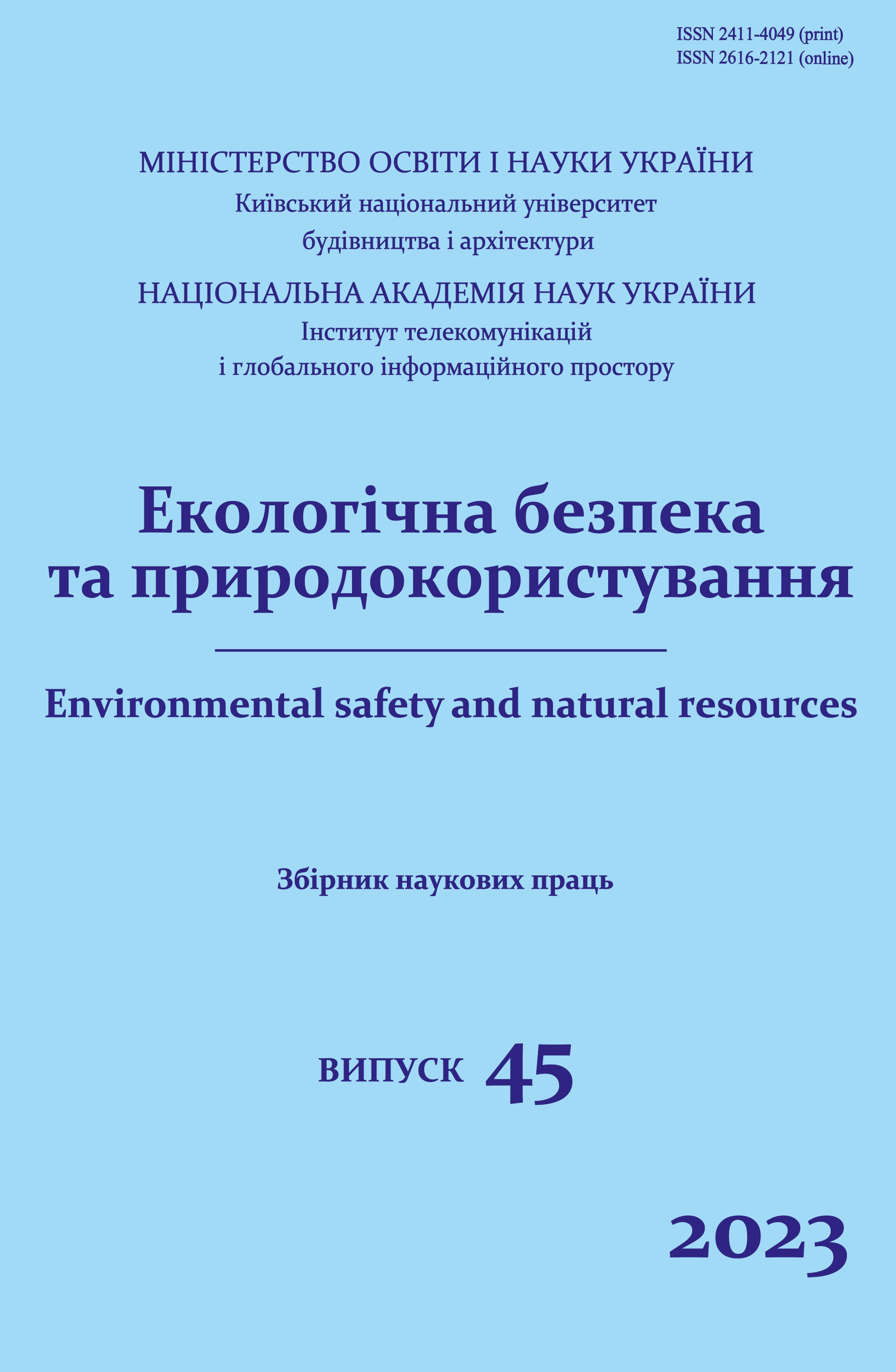The formation of atmospheric air pollution emissions from separate explosions as a result of military operations
DOI:
https://doi.org/10.32347/2411-4049.2023.1.111-120Keywords:
military operations, separate explosion, atmospheric air quality, convective jetAbstract
As is well known, military operations in urbanized areas lead to deterioration of atmospheric air quality. The article examines the model of the formation of atmospheric polluted air from individual explosions as a result of military operations. A technique based on the theory of the convective jet is proposed for estimating the concentrations of hazardous substances formed above the burning area as a result of the explosion. The proposed approach makes it possible to obtain the concentration of pollutants in the conditions of emission into the atmosphere open to solar radiation at a height of three or more diameters of the explosion funnel (or the conventional diameter of the warm surface), the temperature and speed of hot air jets over the warm surface, the consumption of the desired substance. The obtained data make it possible to calculate the emission of hazardous substances into the atmosphere according to the formulas for a high unshaded source of pollution depending on the meteorological conditions of the area, to determine the concentration of the main acid-forming substances when assessing the probability of acid precipitation, and to serve as a basis for modern innovative atmospheric air monitoring systems.
An assessment of the existing approach to determining atmospheric air pollution due to the impact of X-101 missile fragments in Kyiv on December 16, 2022 was made, which is a confirmation of the validity of this approach when calculating the impact of a separate explosion on atmospheric air quality. Calculated emissions of pollutants and their concentrations in the air in the upper part of the convective polluted jet in the case of separate explosions of the Kalibr cruise missile, the Kh-101 missile and the BUK-M1 projectile. The error from the comparison of these calculation results with the atmospheric air monitoring system depends on the nearest active observation points. This approach to assessing and forecasting concentrations of pollutants in atmospheric air can be used under neutral atmospheric conditions that determine the emission of pollutants and transformations of chemical substances in the air.
References
Вelcher, О., Bigger, Р., Neimark, В., & Kennelly, С. (2020). Hidden carbon costs of the “everywhere war”: Logistics, geopolitical ecology, and the carbon boot-print of the US military 2020. Journal Citation Reports (Clarivate Analytics), 14/85 (Geography), 65–80.
Bondar, O. I., Ulytskyi, O. A., & Ermakov, V. M. (2018). Report on the results of studying the ecological situation in Donetsk and Luhansk regions. Kyiv. Retrieved from: http://dea.edu.ua/img/source/Doc/LugDon%20Obl.pdf.
Pereira, Р., Bašić, F., Bogunovic, І., & Barcelo, D. (2022). Russian-Ukrainian war impacts the total environment. Science of The Total Environment, 837. https://doi.org/10.1016/j.scitotenv.2022.155865.
Honcharenko, А., Voloshkina, О., Kupinskyi, І., & Zhukova, О. (2021). Modern comprehensive information system for environmental quality monitoring. Environmental Problems, 6(4), 251-258.
Sydorenko, V. L., & Azarov, S. I. (2010). Assessing the risk of public exposure to the products of an ammunition depot accident. Environmental safety and nature management, 5, 67-74.
Assessment of the consequences of explosions of various ammunition at military warehouses. Retrieved from: https://ldubgd.edu.ua/sites/default/files/3_nauka/vibuhi_boiepripasiv_.pdf.
Gvozdyakov, D., Gubin, V., Gromov, A., Tanishev, A., & Shvab, S. (2022). Numerical Estimation of the Formation Process of Anthropogenic Precipitation in the Atmosphere. https://doi.org/10.1051/matecconf/20179101005.
Methodological guidelines for forecasting meteorological conditions for the formation of air pollution levels in Ukrainian cities. Retrieved from: https://meteo.gov.ua/files/content/docs/meteo_kerdoc/%D0%9A%D0%9452.9.4.01-09.pdf.
Selegay, Т., Filonenko, N., Shlychkov, V., Lezhenin, A., & Lenkovskaya, T. (2013). Formaldehyde pollution of the urban atmosphere and its dependence on meteorological factors. Optics of the Atmosphere and the Ocean, 25(5), 422-426.
Aloyan, A.E. (2000). Numerical modeling of the interaction of gas species and aerosol in the atmospheric dispersive system. Russ. J Num. Analysis Math. Modelling, 15(3-4), 211-224.
Sipakov, R., & Voloshkina, О. (2021). Improving management of environmental risk from urbanized areas highways' air pollution (on an example of Kyiv city). Zenodo May, 4, 2021. https://doi.org/10.5281/zenodo.4735836.
Characteristics of the BUK-M1 projectile. Retrieved from: https://uk.wikipedia.org/wiki/%D0%91%D1%83%D0%BA-%D0%9C1-2.
Caliber (cruise missiles). Retrieved from: https://uk.wikipedia.org/wiki/%D0%9A%D0%B0%D0%BB%D1%96%D0%B1%D1%80_(%D0%BA%D1%80%D0%B8%D0%BB%D0%B0%D1%82%D1%96_%D1%80%D0%B0%D0%BA%D0%B5%D1%82%D0%B8).
Methodology for calculating unorganized emissions of polluting substances or a mixture of such substances as a result of emergency situations and/or during martial law and determining the amount of damage caused. Approved by Order of the Ministry of Environment and Natural Resources of Ukraine on April 13, 2022, No. 175. Retrieved from: https://zakon.rada.gov.ua/laws/show/z0433-22#Text15/.
Meteorological archive. Retrieved from: https://www.meteoblue.com/ru/%D0%BF%D0%BE%D0%B3%D0%BE%D0%B4%D0%B0/historyclimate/weatherarchive/%D0%9A%D0%B8%D0%B5%D0%B2_%D0%A3%D0%BA%D1%80%D0%B0%D0%B8%D0%BD%D0%B0_703448?fcstlength=1m&year=2022&month=2.
Air quality index calculator. Retrieved from: https://web.archive.org/web/20120813235124/http://www.airnow.gov/index.cfm?action=resources.conc_aqi_calc.
Downloads
Published
How to Cite
Issue
Section
License
Copyright (c) 2023 Goncharenko A., Sipakov R.

This work is licensed under a Creative Commons Attribution 4.0 International License.
The journal «Environmental safety and natural resources» works under Creative Commons Attribution 4.0 International (CC BY 4.0).
The licensing policy is compatible with the overwhelming majority of open access and archiving policies.

